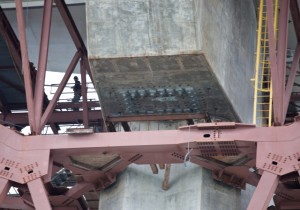MYROW: Are you confident, senator, that Caltrans knows what it's doing?
DESAULNIER: No.
MYROW: Because?
DESAULNIER: Obviously, there was a mistake made on the fasteners that The Chronicle has talked about. There was a mistake made on the bolts, and they have pretty much admitted those mistakes. So, both of those things certainly erode your level of confidence.
MYROW: Do you think this agency has a systemic problem with quality control?
DESAULNIER: I think there's a definite cultural problem at Caltrans. I've run a number of bills, including one last year to create an inspector general's division, which other states have. New York has had one for some time, and it's just had the ability to have outside experts keep a close eye on the Department of Transportation. I was not able to convince the administration to sign that bill. I have another one this year that would move some existing audit functions from under the director of Caltrans to the California Transportation Commission that would, I believe, provide a greater level of accountability and more transparency.
MYROW: Are you at all worried that basically we're going to have a $6.5 billion bike path in a few months?
DESAULNIER: There is a joke, which I don't find too funny, about the world's longest and most expensive fishing pier. My hope is that we will get this bridge open on time, or close to on time. We do know that the existing bridge is not safe. This has always been a race against time since 1989, when Loma Prieta happened. So, it's really important that we focus on safety.
MYROW: Beyond the global embarrassment of the media coverage and the questions being asked about the safety of the new bridge, do you see any sanctions in the future for Caltrans employees or leadership?
DESAULNIER: I think people have to be held accountable. We all expect that in our own jobs, whatever they may be. So, we need to make sure the bridge is safe. Then we have to go back and find out why these mistakes were made and make sure there's corrective action, and part of that corrective action is to hold people accountable.
MYROW: You've had the opportunity, sitting on the Senate Transportation Committee, to really dig into the details in a way that a lot of civilians really haven't. Is there a particular question that's burning for you about how the decision to use this kind of steel was made and then how it wasn't questioned as folks rolled forward with it?
DESAULNIER: I think there's a really interesting analogy in the aerospace field. After the Challenger disaster the Reagan administration put something together called the Rogers Commission -- very, really interesting for discovering that sometimes there's an acceptance institutionalized in these large organizations for safety risks that you shouldn't take, and I think that that's analogous to this situation. I think a lot of good people took risks that they probably shouldn't have. They didn't follow written protocol, and now we are at the end of this long road -- hopefully close to the end -- and we're finding out that it's going to cost more than it ever should have, and we're not certain of the safety. So I think the larger issue is: What happens in these large public institutions? And transparency, I think, is the most important thing. The public should know what they're doing and why they make changes.
MYROW: Senator, thank you for talking with us.
